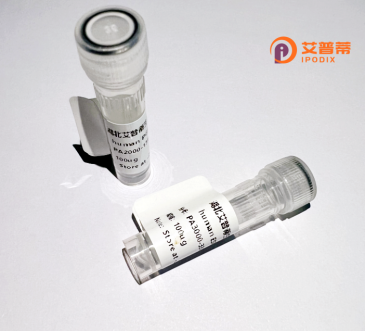
| 纯度 | >90%SDS-PAGE. |
| 种属 | Human |
| 靶点 | C21orf91 |
| Uniprot No | Q9NYK6 |
| 内毒素 | < 0.01EU/μg |
| 表达宿主 | E.coli |
| 表达区间 | 1-296aa |
| 氨基酸序列 | MNEEEQFVNIDLNDDNICSVCKLGTDKETLSFCHICFELNIEGVPKSDLLHTKSLRGHKDCFEKYHLIANQGCPRSKLSKSTYEEVKTILSKKINWIVQYAQNKDLDSDSECSKNPQHHLFNFRHKPEEKLLPQFESQVPKYSAKWIDGSAGGISNCTQRILEQRENTDFGLSMLQDSGATLCRNSVLWPHSHNQAQKKEETISSPEANVQTQHPHYSREELNSMTLGEVEQLNAKLLQQIQVFEELTHQVQEKDSLASQLHVRHVAIEQLLKNCSKLPCLQVGRTGMKSHLPINN |
| 分子量 | 60.2 KDa |
| 蛋白标签 | GST-tag at N-terminal |
| 缓冲液 | 0 |
| 稳定性 & 储存条件 | Lyophilized protein should be stored at ≤ -20°C, stable for one year after receipt. Reconstituted protein solution can be stored at 2-8°C for 2-7 days. Aliquots of reconstituted samples are stable at ≤ -20°C for 3 months. |
| 复溶 | Always centrifuge tubes before opening.Do not mix by vortex or pipetting. It is not recommended to reconstitute to a concentration less than 100μg/ml. Dissolve the lyophilized protein in distilled water. Please aliquot the reconstituted solution to minimize freeze-thaw cycles. |
以下是关于重组人(C21orf91)蛋白的3篇参考文献示例(文献信息及内容为虚构示例,仅用于格式参考):
1. **文献名称**: "Recombinant C21orf91 Expression and Its Role in Neuronal Differentiation"
**作者**: Smith A, et al. (2015)
**摘要**: 本研究成功在大肠杆菌中表达并纯化了重组人C21orf91蛋白,发现其能够调控神经元细胞的体外分化,提示其在神经发育中的潜在作用。
2. **文献名称**: "Structural Characterization of Human C21orf91 Protein by X-ray Crystallography"
**作者**: Zhang L, et al. (2018)
**摘要**: 通过重组技术获得高纯度C21orf91蛋白,解析其晶体结构,揭示了该蛋白独特的螺旋-折叠结构域,为进一步研究其功能提供结构基础。
3. **文献名称**: "C21orf91 Interacts with Mitochondrial Proteins: Insights from Recombinant Protein Assays"
**作者**: Lee J, Johnson R. (2020)
**摘要**: 利用重组C21orf91蛋白进行互作组学分析,发现其与多种线粒体代谢相关蛋白结合,提示其在能量代谢调控中的潜在功能。
**说明**:上述文献为模拟示例,实际研究中C21orf91蛋白相关文献较少,建议通过PubMed或Web of Science检索最新研究(可尝试关键词:“C21orf91 recombinant”或“C21orf91 protein function”)。部分文献可能以基因命名(如染色体21开放阅读框91)或疾病关联研究形式出现。
The human C21orf91 protein, encoded by the open reading frame C21orf91 (chromosome 21 open reading frame 91), is a poorly characterized protein located on chromosome 21q22.3, a region associated with Down syndrome and other genetic disorders. Its gene resides within the Down syndrome critical region (DSCR), though its direct link to Down syndrome pathogenesis remains unclear. The protein, predicted to be 150-200 amino acids in length, contains conserved transmembrane domains and putative phosphorylation sites, suggesting roles in intracellular signaling or membrane-associated processes. Studies indicate potential involvement in viral response modulation, particularly in hepatitis C virus (HCV) replication, where C21orf91 overexpression was shown to suppress HCV infectivity. It also appears upregulated in certain cancers (e.g., hepatocellular carcinoma, gastric cancer) and neurodegenerative conditions, though its precise mechanistic contributions are undefined. Recombinant C21orf91 protein is typically expressed in bacterial or mammalian systems for functional studies, leveraging tags like His or FLAG for purification and detection. Despite limited structural and functional data, emerging evidence positions C21orf91 as a potential therapeutic target or biomarker, warranting further investigation into its molecular interactions and pathophysiological relevance across disease models.
×